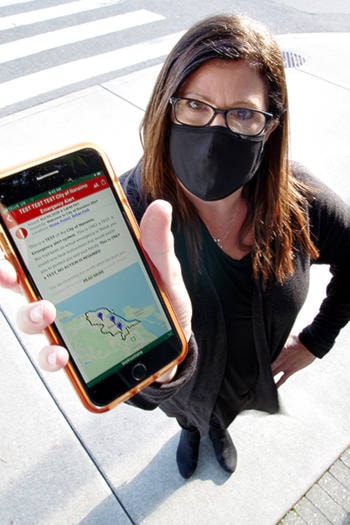It’s that time of year when people get ready to drop, cover and hold on.
The annual provincewide earthquake drill, the Great British Columbia ShakeOut, happens Thursday, Oct. 15.
B.C.’s coast sits on the Cascadia subduction zone, an area that stretches from Vancouver Island to northern California where nine-magnitude megathrust earthquakes happen every few hundred years and pose the most threatening form of natural disaster for the region.
The Great B.C. ShakeOut isn’t just a dry run for the ‘big one’ in which people spend a few minutes to practise taking cover under their desks and then gather in muster areas when the ‘shaking’ stops. It’s a reminder to be prepared for a range of disasters, such as severe storms, wildfires, industrial calamities and major earthquakes that could leave populations stranded without electrical power, food, water, shelter and help from emergency services for days, even weeks.
Karen Lindsay, City of Nanaimo emergency program manager, wants families, businesses, schools and other organizations to focus on disaster preparation and education throughout October.
The Great B.C. ShakeOut drill starts Thursday at 10:15 a.m., when people are asked to take cover and hold on until the ‘shaking’ stops, wait 60 seconds, then get to a clear area outside away from buildings and overhead power lines.
“Technically, it’s not the earthquake that kills you. It’s everything that’s surrounding us. It’s the buildings. It’s the stuff we have in our house,” Lindsay said. “Why we wait for that shaking to stop after the duck, cover and hold is to let everything settle. Then we want you to go outside into an open area away from any danger or objects and assess the facility that you’re in or the home that you live in, understanding that there could be post-earthquake aftershocks.”
October is also the time for families to create or review plans for how they will deal with disasters and compile emergency preparedness kits with sufficient food, water, medications, first aid supplies and other items to help people survive for several days after a major disaster. Lindsay said a well-provisioned and maintained emergency kit and stock of necessities at home can help prevent panic buying, such as what happened in March and April after the COVID-19 pandemic became an emergency in B.C.
“Pandemic is one of our top five that we’ve identified in our hazard assessment and what we always said is it was ‘one plane ride away’ and here we are, one plane ride away,” Lindsay said.
Even if illness from a pandemic hasn’t stricken residents here, its effects elsewhere can impact services normally taken for granted, such delivery of food, supplies and other goods, be it the result of supply lines overseas or shortages created by panic buying at home.
“Also we’re getting into our winter season,” Lindsay said. “We remember 2018 and the severe windstorms we had, so we want to remind our residents to start preparing for our storm season and let’s hope that we don’t have a recurrence of the windstorm or severe weather that we did.”
Information about how to prepare for the most common emergencies is available on the City of Nanaimo website at www.nanaimo.ca/city-services/emergency-services and on the the Great British Columbia ShakeOut website at www.shakeoutbc.ca.
READ ALSO: City of Nanaimo to issue alert as it moves to new emergency information system
The city will also be testing its Voyent Alert system on Oct. 27, which will transmit a test emergency alert via multiple communications modes.
“It will come out in a text, phone call and e-mail, so we’ll use all three methods of communication,” Lindsay said. “[We] encourage people to sign up because it is an important tool that we can use, should communications still be up and running … That might not be the case following an earthquake, but for more frequent emergencies, it’s a tool that we can use and we use it only when absolutely necessary.”
To learn more about the Voyent Alert system and to sign up to receive system notifications, visit the city website at www.nanaimo.ca and search ‘Voyent Alert.’
photos@nanaimobulletin.com
Like us on Facebook and follow us on Twitter
